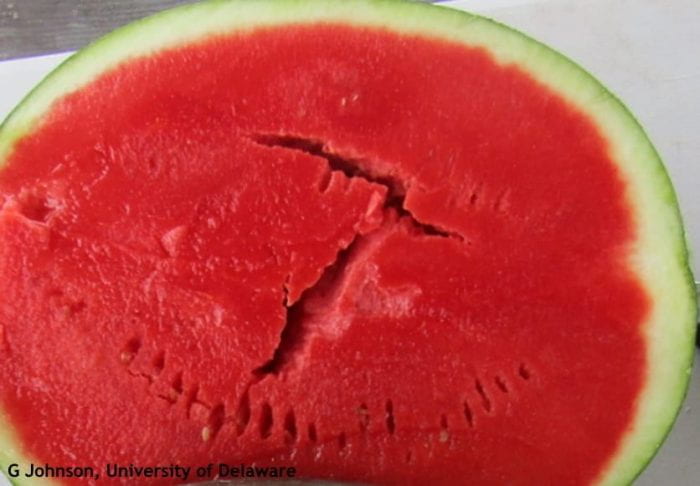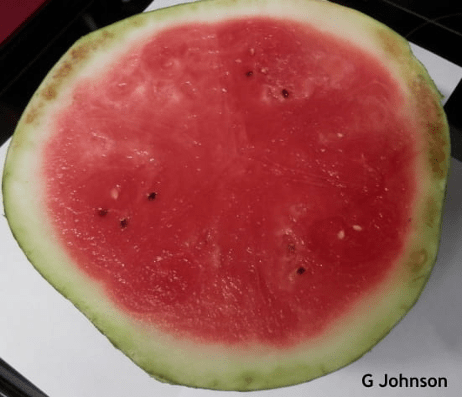– Gordon Johnson, Extension Vegetable & Fruit Specialist; gcjohn@udel.edu
Hollow Heart
Hollow heart is an internal crack in the flesh of the melon. Hollow heart is generally more severe in seedless varieties and in crown-set fruit. Inadequate pollination has been shown to be one causal factor. Cold weather during fruit set, poor fruit set and low fruit load, inadequate bees or poor-quality hives, and other factors affecting bee flights have been reported to impact the severity of hollow heart.

Hollow heart
Internal Rind Necrosis
Internal rind necrosis is indicated by the presence of a corky, red-brown layer of tissue on the inside of the rind of affected fruit without extending into the fruit flesh. The disease occurs sporadically and is thought to be caused by bacteria that are naturally present in fruit. Drought stress has been implicated in this disorder.

Internal rind necrosis
Irregular Ripening
Irregular ripening can be a problem in some years and varieties. Watermelons are classified as non-climacteric since they do not ripen significantly after harvest. However, research has shown that watermelon fruit produce a burst of ethylene at the white fruit stage and factors that reduce ethylene at this stage will slow ripening. Watermelon fruit development and ripening also depend on the accumulation of sugars. Loss of foliage or stem tissue due to diseases such as gummy stem blight or insect or mite feeding can reduce the amount of sugars available to the fruit. Different varieties, low K nutrition, or variability in vine health will lead to variability in fruit ripening.
Misshapen Fruits
Poor pollination due to low bee activity, may result in “bottlenecks”, or constricted growth at the stem end of the fruit, especially in seeded/elongated watermelons. Research has shown that the distribution of a minimum of 1,000 pollen over the three lobes of the flower stigma are required to produce a uniformly shaped fruit. In seedless watermelons, poor pollination may lead to undesirable “triangular” fruit.
Ozone Injury
Ozone is a common air pollutant. When present in high concentrations, ozone will cause chlorosis and upper surface bronzing and scorching in older leaves, which leads to defoliation. Damage is more prevalent when fruits are maturing or when plants are under stress. Injury is seen on crown leaves first and then progresses outward. Seedless watermelon varieties tend to be more resistant to air pollution injury than seeded varieties, so injury often shows up on the pollenizer plants first. “Ice box” types are the most susceptible.

Ozone damage
Sunscald
Sunscald occurs when fruit are exposed to direct sunlight, especially on extremely hot days. Under these conditions, rind surfaces can reach temperatures exceeding 120°F (60°C), killing cells and resulting in sunburn spots. Fruit with little or no foliar cover are at most risk. Sunscald or sunburn first appears as a gray or white area on the exposed upper surface of the fruit. Fruit with dark rinds are more susceptible to sunscald than those with light colored rinds. Sunscald severity is related directly to fertility regime and foliage cover. Proper fertility and soil management promotes adequate vine growth and coverage of fruit. Sunscald severity is also associated with diseases that reduce foliage cover. Storm damage that exposes fruit also can lead to more sunscald.
Water Soaking
Water soaking occurs where excess water accumulates at the bottom of the fruit resulting in a water-soaked appearance of internal flesh. Water accumulates during cloudy weather when transpiration from vines is low. Water soaking sometimes appears in fruits where foliage has deteriorated since excess water cannot be transpired.
Splitting
Splitting during handling occurs in fruit under excessive water pressure because of excess irrigation or rainfall.
